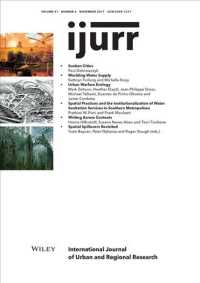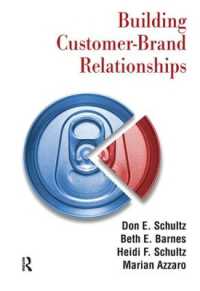Full Description
The key points are the authors (editing and headnotes), broader readings (for political and historical context), historical sequence (with flexibility to suit both new and traditional courses), and pedagogy to encourage learning and critical thinking. Political science majors and future practicing lawyers alike will appreciate this "historical institutional " context, seeing the law as a vital part of the political process. They will see how the Constitution and the courts are influenced by politics, how other factors and players shape the law beyond the Supreme Court, and how history is in turn a struggle for constitutional authority. And they are reinforced and challenged at every step by bulleted summaries, questions, and other pedagogynot found in any other text. * Each volume proceeds chronologically, with extensive historical background and with consistent topical structure from chapter to chapter, to stress how the law has developed over time, within the politics and culture of its age. Each volume thus ends with current controversies. * Additional documents beyond Supreme Court cases make the book more comprehensive, historical, and vivid - from great speeches (by Daniel Webster, Abraham Lincoln, and others) and presidential vetoes to issues and controversies today. * Extensive historical introductions precede each chapter's cases. * Many examples make the struggle for constitutional authority vivid, from Marbury v. Madison to the New Deal and today. * Chapter 1 introduces critical questions right away: What is the Constitution, who interprets it, and how does it change? * Chapter 1 also introduces comparative governments early. * Many more readings are available in the package online. * Of course, three stellar scholars are our authors, and their excerpting and editing of readings is a itself a major feature. * Yet additional readings, as well as full cases, are on the companion Web site. There is, quite simply, more pedagogy and art than in other books: * Main sections open with bulleted Major Developments. * Questions at end of each headnote encourage critical thinking. * Notes explicate court decisions. Chapters end with further readings. * Historical images and maps add unique interest. * A case study in the introductory chapter integrates constitutional issues into history, (tentatively "The Negro Seamen's Act "). * An appendix on doing legal research and reading court cases helps students with the methodology of political science. * Again, an alternate table of contents adds flexibility, as a correlation guide.
Contents
*=New to this EditionTopical Outline of Volume I: Tables, Figures, and Illustrations: Preface: PART 1. THEMES1. Introduction to American ConstitutionalismI. What Is a Constitution?II. Constitutional PurposesIII. Constitutional Interpretation and Decision MakingIV. Constitutional AuthorityV. Constitutional ChangeVI. Constitutional Politics and LawPART 2. DEVELOPMENT2. The Colonial Era, Before 1776I. IntroductionII. Judicial Power and Constitutional AuthorityWilliam Blackstone, Commentaries on the Laws of EnglandMassachusetts Assembly MemorialJohn Dickinson, Letters from a Farmer in PennsylvaniaIII. Powers of the National GovernmentThomas Whately, The Regulations Lately MadeDaniel Dulany, Considerations of the Propriety of Imposing Taxes in the British ColoniesIV. Separation of PowersBoston List of InfringementsThe Declaration of Independence3. The Founding Era, 1776-1788I. IntroductionII. Judicial Power and Constitutional AuthorityA. Judicial Review"Brutus"The Federalist, No. 78B. The Absence of a Bill of Rights* The Federalist Response to Anti-Federalist CriticsJames Wilson, State House Yard SpeechThe Federalist, No. 84III. Powers of the National GovernmentArticles of ConfederationThe Virginia PlanThe New Jersey PlanArticle I, Section 8 of the Constitution of the United StatesSamuel Adams, Letter to Richard Henry LeeThe Federalist, Nos. 1, 10, and 23IV. FederalismA. Representation of State InterestsDebate in the Constitutional ConventionMelancton Smith, Speech to the New York Ratification ConventionV. Separation of PowersDebate in the Constitutional ConventionThe Federalist, Nos. 51, 70, and 71"Centinel," Letter No. 14. The Early National Era, 1789-1828I. IntroductionAlexander Hamilton, Report on ManufacturersThomas Jefferson, First Inaugural AddressII. Judicial Power and Constitutional AuthorityA. Judicial ReviewCalder v. BullMarbury v. MadisonB. Judicial SupremacyThomas Jefferson on DepartmentalismC. Federal Review of the StatesMartin v. Hunter's Lessee* Barron v. BaltimoreIII. Powers of the National GovernmentA. General PrinciplesB. Necessary and Proper ClauseDebate on the Bank of the United States--House Debate on the Bank--Thomas Jefferson, Opinion on the Constitutionality of the Bill for Establishing a National Bank--Alexander Hamilton, Opinion as to the Constitutionality of the Bank of the United States--McCulloch v. Maryland--Spencer Roane and John Marshall on McCulloch v. MarylandDebate on the Military Draft--James Monroe, Proposal for a Military Draft--Daniel Webster, Speech on the Proposed Military DraftC. Territorial Acquisition and GovernanceSenate Debate on the Louisiana PurchaseHouse Debate on the Missouri CompromiseD. Power to Regulate CommerceUnited States v. The WilliamJosiah Quincy, Speech on Foreign RelationsGibbons v. OgdenE. Taxing and Spending PowerHouse Report on Internal ImprovementsJames Monroe, "Views of the President of the United States on the Subject of Internal Improvements"IV. FederalismA. Sovereign ImmunityChisholm v. GeorgiaB. State Authority to Interpret the ConstitutionVirginia and Kentucky Resolutions of 1798Resolution of the State of Rhode Island and Providence Plantations to VirginiaV. Separation of PowersA. General PrinciplesB. Appointment and Removal PowersHouse Debate on Removal of Executive OfficersC. Executive PrivilegeHouse Debate on the Jay TreatyGeorge Washington, Response to the House on the Jay TreatyJames Madison, Response to the President's MessageD. Legislative Powers of the PresidentE. Elections and Political Parties5. The Jacksonian Era, 1829-1860I. Introduction"An Introductory Statement of the Democratic Principle," The Democratic ReviewJohn Quincy Adams, First Annual MessageII. Judicial Power and Constitutional AuthorityA. Judicial Structure and Judicial SelectionDebate on the Electoral Accountability of the Judiciary, Ohio Constitutional ConventionB. Constitutional LitigationLuther v. Borden* C. Federal Review of the States* Barron v. BaltimoreIII. Powers of the National GovernmentA. Necessary and Proper ClauseAndrew Jackson, Veto Message Regarding the Bank of the United StatesB. Fugitive Slave ClauseSalmon Chase, Speech in the Case of the Colored Woman MatildaPrigg v. PennsylvaniaJohn J. Crittenden, Opinion on the Constitutionality of the Fugitive Slave BillC. Territorial Acquisition and GovernanceCongressional Debate on the Annexation of TexasDred Scott v. SandfordAbraham Lincoln, Speech on Slavery in the TerritoriesIV. FederalismA. States and the Commerce ClauseCooley v. Board of Wardens of the Port of PhiladelphiaB. State Authority to Interpret the ConstitutionJohn C. Calhoun, "Fort Hill Address"C. States and Native American SovereigntyWorcester v. GeorgiaV. Separation of PowersA. Presidential Power to Execute the LawThe Debate over the Removal of the DepositsAndrew Jackson, Paper on the Removal of the DepositsHenry Clay, Speech on the Removal of the DepositsAndrew Jackson, Protest of the Censure ResolutionB. Presidential War and Foreign Affairs PowersJames Polk, Second Annual MessageHouse Debate on the Constitutionality of the Mexican WarC. Legislative Powers of the PresidentHouse Debate on the Veto Power6. Secession, Civil War, and Reconstruction, 1861-1876I. IntroductionII. Constitutional Authority and Judicial PowerA. Judicial Structure and SelectionB. Judicial SupremacyLincoln on DepartmentalismC. Constitutional LitigationEx parte McCardleIII. Powers of the National GovernmentA. Necessary and Proper ClauseCongressional Debate on the Legal Tender BillHepburn v. GriswoldLegal Tender CasesB. Federal Power to Enforce Civil RightsSenate Debate over the Civil Rights Act of 1866Civil Rights Act of 1866IV. FederalismA. SecessionSouth Carolina Ordinance of SecessionJeremiah Black, Opinion on the Power of the President in Executing the LawsAbraham Lincoln, First Inaugural AddressB. Federalism during the Civil War1. Federalism in the North2. Federalism in the SouthC. The Status of the Southern States during ReconstructionWilliam T. Sherman, "Memorandum"Andrew Johnson, First Annual MessageHenry Winter Davis, "No Peace Before Victory"Charles Sumner, "State Rebellion, State Suicide"Thaddeus Stevens, Speech on ReconstructionTexas v. WhiteD. Constitutional Amendment and RatificationV. Separation of PowersA. General PrinciplesAbraham Lincoln, Fourth of July Message to CongressB. Martial Law and Habeas CorpusEx parte MerrymanEdward Bates, Opinion on the Suspension of the Privilege of the Writ of Habeas CorpusThe Habeas Corpus Act of 1863C. Presidential War and Foreign Affairs PowersAbraham Lincoln, "Emancipation Proclamation"Benjamin Curtis, Executive PowerThe Prize CasesD. Impeaching and Censuring the President7. The Republican Era, 1877-1932I. IntroductionDavid J. Brewer, "The Nation's Safeguard"Woodrow Wilson, "The Meaning of Democracy"II. Judicial Power and Constitutional AuthorityA. Judicial ReviewSlaughter-House CasesTheodore Roosevelt, "A Charter of Democracy"William Howard Taft, Veto of Arizona StatehoodB. Constitutional LitigationFrothingham v. MellonIII. Powers of the National GovernmentA. Federal Power to Enforce Civil RightsCivil Rights CasesCongressional Debate on LynchingB. Power to Regulate CommerceSenate Debate on the Sherman Anti-Trust ActUnited States v. E.C. Knight CompanyChampion v. Ames ("The Lottery Case")Hammer v. DagenhartC. Taxing and Spending PowerPollock v. Farmers' Loan and Trust CompanyPollock v. Farmers' Loan and Trust Company (Rehearing)Bailey v. Drexel Furniture Company ["The Child Labor Tax Case"]D. Treaty PowerMissouri v. HollandE. Necessary and Proper ClauseSelective Draft Law Cases (Arver et al. v. U.S.)IV. FederalismA. States and the Commerce ClauseWabash, St. Louis & Pacific Railroad v. IllinoisB. Police PowersThomas M. Cooley, Constitutional LimitationsMunn v. State of IllinoisC. Representation of State InterestsGeorge F. Hoar, "Direct Election of Senators"V. Separation of PowersA. Appointment and Removal PowerMyers v. United StatesB. Inherent Presidential PowerPresidents on Presidential Power--Grover Cleveland, "The Independence of the Executive"--Theodore Roosevelt, An Autobiography--William Howard Taft, Our Chief Magistrate and His Powers--Woodrow Wilson, Constitutional Government in the United StatesC. Nondelegation of Legislative PowerJ.W. Hampton, Jr. & Co. v. United StatesD. Elections and Political Parties8. The New Deal and Great Society Era, 1933-1968I. IntroductionFranklin D. Roosevelt, Commonwealth Club AddressDwight Eisenhower, Letter to Edgar Newton EisenhowerII. Judicial Power and Constitutional AuthorityA. Judicial ReviewUnited States v. Carolene ProductsB. Judicial SupremacyFranklin Roosevelt, Undelivered Speech on the Gold-Clause CasesFranklin Roosevelt, Fireside Chat on Court-Packing PlanSenate Judiciary Committee Report on President Roosevelt's Court-Packing PlanThe Southern ManifestoDwight Eisenhower, Address to the Nation on the Introduction of Troops in Little RockCooper v. AaronC. Constitutional LitigationNote: Declaratory JudgmentsFlast v. CohenBaker v. CarrD. Federal Review of the StatesIII. Powers of the National GovernmentA. Power to Regulate CommerceSchechter Poultry Corp. v. United StatesNational Labor Relations Board v. Jones & Laughlin Steel Corp.Wickard v. FilburnJustice Robert Jackson, Memo on WickardB. Federal Power to Enforce Civil RightsCongressional Debate over the Civil Rights Act of 1964Heart of Atlanta Motel, Inc. v. United StatesSouth Carolina v. KatzenbachC. Taxing and Spending PowerUnited States v. ButlerSteward Machine Co. v. DavisIV. FederalismV. Separation of PowersA. General PrinciplesYoungstown Sheet & Tube Co. v. Sawyer* B. Presidential War and Foreign Affairs Powers* Department of State, Memorandum on the Authority of the President to Repel Attack in KoreaC. Appointment and Removal PowersHumphrey's Executor v. United StatesD. Nondelegation of Legislative PowersSchechter Poultry Corp. v. United StatesUnited States v. Curtiss-Wright Export CorporationE. Executive PrivilegeWilliam P. Rogers, Senate Testimony on Executive Privilege9. Liberalism Divided, 1969-1980I. IntroductionRichard M. Nixon, Speech Accepting the Republican Presidential NominationJimmy Carter, Inaugural AddressII. Judicial Power and Constitutional AuthorityA. Constitutional LitigationPowell v. McCormackLaird v. TatumRehnquist Memo in Laird v. TatumIII. Powers of the National GovernmentIV. FederalismA. State Immunity from Federal RegulationNational League of Cities v. UseryV. Separation of PowersA. Presidential War and Foreign Affairs PowersLeonard C. Meeker, The Legality of the United States' Participation in the Defense of Viet-NamJ. William Fulbright, Congress and Foreign PolicyThe War Powers Act of 1973Richard Nixon, Veto of the War Powers ResolutionUnited States v. United States District Court (the "Keith Case")B. Executive PrivilegeUnited States v. NixonPART 3. CONTEMPORARY ISSUES10. The Reagan-Bush Era, 1981-1993I. IntroductionRonald Reagan, First Inaugural AddressII. Judicial Power and Constitutional AuthorityA. Judicial SupremacyEdwin Meese, "The Law of the Constitution"B. Judicial ReviewWilliam H. Rehnquist, "The Notion of a Living Constitution"William J. Brennan, "The Constitution of the United States: Contemporary Ratification"The Nomination of Robert H. Bork to the U.S. Supreme CourtRonald Reagan, "Address to the Nation"Senate Judiciary Committee Hearings on the Nomination of Robert BorkIII. Powers of the National GovernmentA. General PrinciplesRonald Reagan, Remarks at the National Conference of State LegislaturesB. Taxing and Spending PowerSouth Dakota v. DoleIV. FederalismA. States and the Commerce ClauseGarcia v. San Antonio Metropolitan Transit Authority et al.B. Constitutional Amendment and RatificationV. Separation of PowersA. Sharing the Legislative PowerImmigration and Naturalization Service v. ChadhaB. Presidential Power to Execute the LawMorrison v. Olson11. The Contemporary Era, 1994-PresentI. IntroductionWilliam J. Clinton, Fourth Annual MessageBarack Obama, Inaugural AddressII. Judicial Power and Constitutional AuthorityA. Judicial ReviewCity of Boerne v. FloresThe Nomination of Samuel Alito to the U.S. Supreme CourtB. Constitutional LitigationDoe v. BushMassachusetts v. Environmental Protection AgencyC. Judicial Structure and SelectionSenate Debate on the "Nuclear Option"III. Powers of the National GovernmentA. Power to Regulate CommerceUnited States v. Lopez* National Federation of Independent Business v. SebeliusB. Federal Power to Enforce Civil RightsUnited States v. MorrisonIV. FederalismA. State Regulation of Federal ElectionsU.S. Term Limits v. ThorntonB. Non-CommandeeringPrintz v. United StatesC. Sovereign ImmunityAlden v. Maine* D. States and the Commerce Clause* Granholm v. HealdV. Separation of PowersA. Sharing the Legislative PowerClinton v. City of New YorkB. Presidential Power to Execute the LawWalter Dellinger, "Presidential Authority to Decline to Execute Unconstitutional Statutes"C. Presidential War and Foreign Affairs PowersJohn Yoo, The President's Constitutional Authority to Conduct Military OperationsMemoranda on Standards of Conduct of Interrogation ("Torture Memos")Jay S. Bybee, Memo to Alberto R. Gonzales, Counsel to the PresidentJohn Yoo, Memo to William Haynes II, General Counsel of the Department of DefenseDaniel Levin, Memo to James B. Comey, Deputy Attorney GeneralCaroline D. Krass, Memorandum Opinion on the Authority to Use Military Force in LibyaJohn Cornyn, Speech on Congressional Authorization to Use Military Force in LibyaD. Martial Law and Habeas CorpusHamdi v. RumsfeldE. Executive PrivilegeCheney v. United States District Court for the District of ColumbiaF. Immunity from Judicial ProcessesClinton v. JonesAPPENDICES1. Constitution of the UnitedStates of America2. Researching and Reading Government Documents3. Chronological Table of Presidents, Congress, and the Supreme CourtGlossary: Index:








